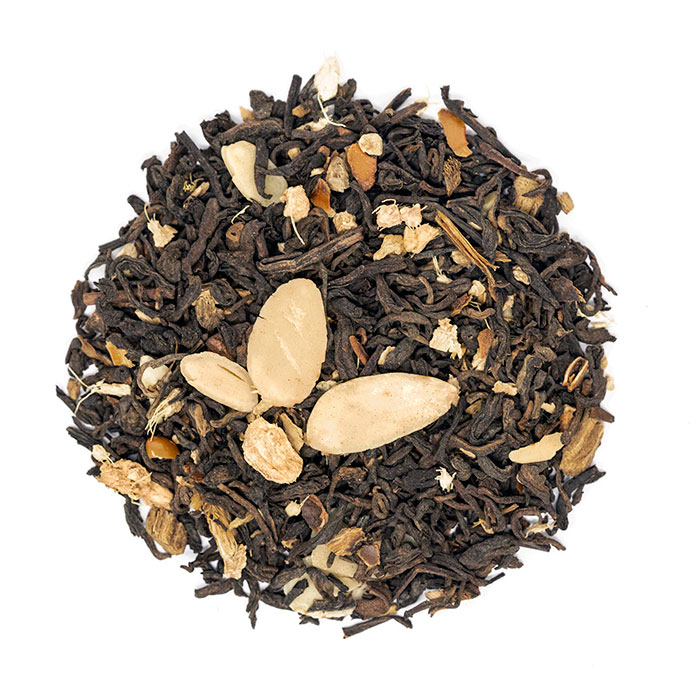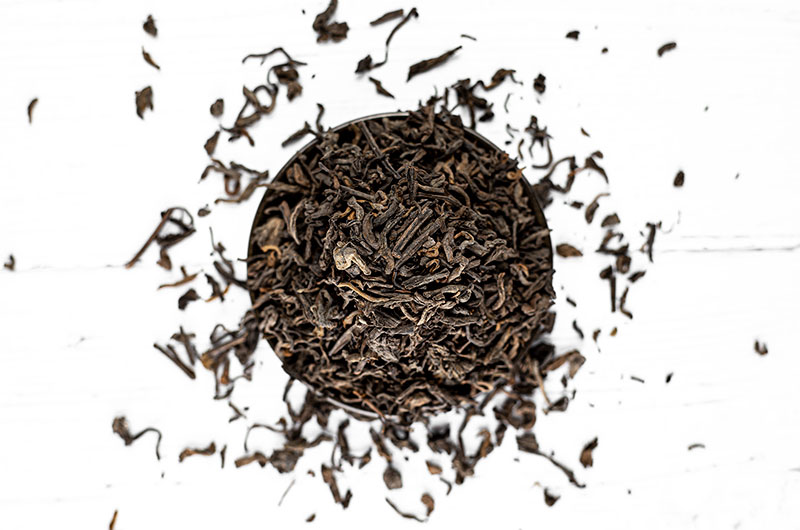What is Pu erh Tea?
If you never tasted pu’erh tea before, the first cup may bring a surprise. Flavor of this tea very different from the flavor of any other tea in the world and some benefits may surpass even those of green, black or white tea. Pu’er is so special that some tea drinkers are refusing to drink anything but pu’erh.
What is pu erh tea?
Although it looks like a black tea, pu’erh belongs to a group of dark or fermented teas. With a history of more than a thousand years, it’s one of the oldest types of tea in the world. In smaller amounts, fermented or dark teas are produced in some other countries too, such as Japan, Malawi or Vietnam, but Pu’erh belongs exclusively to the Chinese Yunnan province.
Just like all other real types of tea, pu’erh is made from Camellia sinensis tea leaves. Interestingly, pu’erh is made from assamica variety, same as the Assam black teas, but not from the same cultivar. Tea leaves are fermented either naturally by aging or by controlled fermentation. Except polyphenols and caffeine, pu’erh contains a whole variety of different fungi and bacteria, with raw pu’erh being more rich in fungi and ripe in bacteria.
The shapes of pu’erh tea
Pu’erh tea can be found in many different shapes – from loose leaf style to tea compressed into cakes, bird’s nests, mushrooms, and other shapes. Compressed types are available in many sizes, from mini cakes to bigger, over 300 gram bricks or cakes. But not only pu’erh is compressed – some oolong, yellow or white tea can be compressed too.
Raw or Ripe pu’erh
There are two types of pu’erh tea – raw or sheng pu erh and ripe or shou pu erh. Raw tea is a naturally fermented tea whose flavor become better with aging, while the ripe pu’erh is suitable for drinking immediately. The popularity of pu’erh rose in the 1970s with the invention of ripe pu erhs that made production of this tea faster and easier.
Pu’erh is like a champagne among teas. Some cakes can be so expensive that the price can easily exceed the cost of an average monthly rent. The most expensive teas are made from wild tea leaves, and have been aged for decades in order to achieve smooth, mellow and rich flavor.
Ripe pu’erh can be aged too, but the aging process will not influence the flavor drastically, as it will with the raw pu’erh. Over time microbial community will significantly change only in raw pu erh[1].
For both types, tea heaves are first dried in the sun. Raw pu’erh is shaped then left to age in special conditions, while ripe pu’er te leaves are being fermented through a process called piling. Leaves are shaped after the fermentations. Some teas are sold immediately, while others are left to age first.
Caffeine content in pu’erh tea
It’s difficult to say how much caffeine pu’erh has. One research showed that Pu’erh has similar levels of caffeine as Chinese sencha or other Chinese pan-fired teas, and less than white or black tea. With 12.59[2] mg of caffeine per gram of dried leaf, pu’erh may be among teas with lower caffeine content. Another study examined the caffeine levels of 7 different pu’erhs and concluded that on average, pu’er contains 37.1 mg of caffeine[3]. Every tea is different and the final amounts will depend on many factors, but it’s likely that a cup of pu’erh tea will have around 30-50 mg of caffeine. However, use this only as a reference number as your tea may have more or less caffeine.
What are the health benefits of drinking pu’erh tea?
Raw or ripe, they both have similar unique benefits. Unlike green tea, pu’erh has a very low level of EGCg and almost zero L-theanine. However, it’s still considered one of the healthiest drinks in the world – especially for weight loss, lowering blood sugar and reducing the risk of cardiovascular diseases. What makes pu’erh healthy is not only the usual tea compounds, it’s the presence of different bacteria that may be beneficial for digestion and managing weight. Bacteria increases the levels of other beneficial compounds through the process of fermentations, for example statins.
A Research published in the Journal of Agricultural and Food Chemistry showed that some strains of bacteria during a short-term fermentation may increase the levels of statins, GABA and polyphenols[4]. Although all real teas come from the same tea plant, they don’t go through the process of fermentation, and have a different chemical composition that dark teas.
Weight loss benefits of pu’erh
Statins have „hypolipidemic and anti inflammatory effects[5]“ and may reduce the risk of stroke and heart attack by 25%[6]. However, the levels of statins won’t be the same in all pu’erhs, and may be much lower than the regular dose in a prescribed statins drugs[7]. The mechanism behind pu’erhs benefits may be much more complexed. Another compound, theabrownin, may have a significant role in lowering cholesterol and lipids too. The most recent Chinese study on pu’erh compared this tea with green and black tea, and concluded that pu’erh is more effective for weight management than other types[8]. Another study showed that the daily drinking of pu’erh tea is „associated with significant weight loss, reduced body mass index, and an improved lipid profile.[9]“
Interestingly, pu’erh seems to be one of the most researched teas, and the one where evidence for the potential benefits is not lacking.
Read more: What Science Says about Pu’erh Tea
Is pu’erh flavored or scented tea?
Pu’erh has a very strong and unique taste, and it’s rarely flavored or scented. It’s mostly appreciated pure. In fact, there are hundreds of different subtle notes in a properly brewed raw and ripe pu’erh. Pu’erh is a tea with both soul, character and personality, especially if aged for many decades and harvested from ancient tea trees. However, it can be scented or flavored, mostly with flowers or chocolate, earthly or spicy flavors.

Wisdom’s Chai with pu’erh tea
How to brew pu erh tea
Ripe Pu’erh is very easy to brew, both using wither eastern or western brewing technique. For both methods you will need a strainer or a special Chinese teapot. You can use filters for pu’erh tea brewing too. Both linen and paper filters will work well with ripe pu’er because the flavor is often strong enough to cover any potential “paper notes” from regular paper filters.
Always use freshly boiled spring water. Ripe pu’erh has no bitterness, and it’s almost impossible to over-brew it. This makes it a great choice for beginners too. Pu’erh is always better when made with hot water, and one of rare teas that can be difficult to cold-brew. However, it can make a great iced tea, especially if scented or flavored with flowers and fruits.
To see the best benefits drink pu’erh after, not before a meal, and not straight after eating.
Eastern-style brewing method
If you are brewing compressed pu’erh rather than loose leaf tea, or raw pu’erh instead of ripe pu’erh, eastern-style brewing may be a better option. Raw pu’erh can get bitter if over-brewed, especially with lower quality leaves. Ripe pu’erh may need an extra few seconds to release flavors. Wash the tea leaves first with one short 15-20 seconds steep and discard the water. If needed, you can repeat the washing step one more time. Start with short 20-30 seconds infusion and add extra seconds for every subsequent steep.
You can re-steep pu’erh tea for at least 5-10 times, depending on the type, quality and style. Some teas may give even up to 20 great cups. Pu’erh should never be bitter, even when it’s raw. Keep the water temperature for both types at around 203-212°F.
Western-style brewing method
Always wash the tea leaves first with one short 10-20 seconds steep. Use one leveled teaspoon of pu’erh loose leaf tea per cup of water. Alternatively, you can make a bigger pot with one spoon of tea leaves and about 1 litre of water. Although the ideal steep time should be at around 3-5 minutes, ripe pu’erh won’t become bitter even if you brew it for more than 10 or 20 minutes. It won’t become bitter even if you completely forget about it and leave it to steep for an hour or two. Use the water temperature at around 212°F. For the best flavor, let it steep for 5 minutes. For raw pu’erh, the previous method may be a much better option.
Where to buy pu erh tea
Pu’erh is available in many online shops. Tea bags can be bought from some convenience stores too. However, pu’erh may be one of the teas that you shouldn’t buy from an unknown tea vendor. Those healthy bacteria in this tea may turn into a bad bacteria very easily and how and where it was produced will make a big difference. Organic pu’erh is still very rare, and often, the most expensive bricks will never be organically grown.
Disclaimer: This article is for informational purposes only. It’s not intended to replace medical advice, diagnosis or treatment. Every person is different and may react to different herbs and teas differently. Never use teas or herbs to treat serious medical conditions on your own. Always seek professional medical advice before choosing home remedies.
References:
[1] https://www.ncbi.nlm.nih.gov/pmc/articles/PMC4918958/
[2] https://www.ncbi.nlm.nih.gov/pmc/articles/PMC4787341/
[3] https://onlinelibrary.wiley.com/doi/pdf/10.1002/jsfa.1857
[4] https://pubs.acs.org/doi/pdf/10.1021/jf071629p
[5] https://pubs.acs.org/doi/pdf/10.1021/jf071629p
[6] https://www.hopkinsmedicine.org/health/conditions-and-diseases/high-cholesterol/3-myths-about-cholesterol-lowering-statin-drugs
[7] https://www.ncbi.nlm.nih.gov/pmc/articles/PMC4818050/




